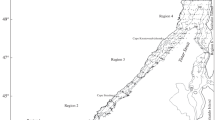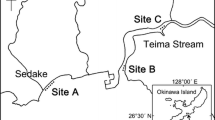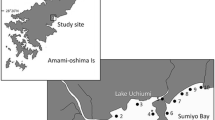Abstract
Phyllosoma larvae collected to date in Japanese and Taiwanese waters have been classified into two genera (Linuparus, Panulirus) of the Palinuridae, four genera (Ibacus, Parribacus, Scyllarides, Scyllarus) of the Scyllaridae, and one genus (Palinurellus) of the Synaxidae. However, phyllosoma larvae of three Scyllarus species (S. bicuspidatus, S. cultrifer, S. kitanoviriosus) are absolutely dominant among the larvae collected in the waters. Scyllarus larvae are abundant in coastal waters while those of Panulirus are often collected in offshore/oceanic waters. Based on previous and ongoing studies dealing with spatial distributions of phyllosoma larvae in Japanese and Taiwanese waters, it appears that phyllosoma and nisto larvae of the Scyllarus are retained within coastal waters north of the Kuroshio Current. On the other hand, the life history of the Panulirus (particularly P. japonicus) may be completed within the Kuroshio Subgyre: their phyllosoma larvae may be flushed out from coastal waters into the Kuroshio, then transported through the Counter Current south of the Kuroshio into the water east of Ryukyu Archipelago and Taiwan where they attain the subfinal/final phyllosoma or puerulus stages, once again entering the Kuroshio and dispersing into coastal waters.
Similar content being viewed by others
References
Baisre, J. A. (1994): Phyllosoma larvae and the phylogeny of Palinuridea (Crustacea: Decapoda): a review. Aust. J. Mar. Freshwat. Res., 45, 925–944.
Booth, J. D. (1994): Jasus edwardsii larval recruitment off the east coast of New Zealand. Crustaceana, 66, 295–317.
Booth, J. D. and B. F. Phillips (1994): Early life history of spiny lobster. Crustaceana, 66, 271–294.
Chan, T. Y. and K. H. Chu (1996): On the different forms of Panulirus longipes femoristriga (Von Martens, 1872) (Crustaceana: Decapoda: Palinuridae), with description of a new species. J. Nat. Hist., 30, 367–387.
Chan, T. Y. and P. K. L. Ng (2001): On the nomenclature of the commercially important spiny lobsters Panulirus longipes femoristriga (Von Martens, 1872), P. bispinosus Borradaile, 1899, and P. albiflagella Chan & Chu, 1996 (Decapoda, Palinuridae). Crustaceana, 74, 123–127.
Chan, T. Y. and H. P. Yu (1986): A report on the Scyllarus lobsters (Crustacea: Decapoda: Scyllaridae) from Taiwan. J. Taiwan Mus., 39, 147–174 (in Chinese).
Chan, T. Y. and H. P. Yu (1992): Scyllarus formosanus, a new slipper lobster (Decapoda, Scyllaridae) from Taiwan. Crustaceana, 62, 121–127.
Chan, T. Y. and H. P. Yu (1995): The rare lobster genus Palinustus A. Milne Edwards, 1880 (Decapoda: Palinuridae), with description of a new species. J. Crust. Biol., 15, 376–394.
Chiswell, S. M. and J. D. Booth (1999): Rock lobster Jasus edwardsii larval retention by the Wairarapa Eddy off New Zealand. Mar. Ecol. Prog. Ser., 183, 227–240.
Cobb, J. S. (1997): Oceanic processes affecting lobster larvae: report from a workshop. Mar. Freshwat. Res., 48, 771–775.
De Bruin, G. H. P. (1962): Spiny lobster of Ceylon. Bull. Fish. Res. Stn. Ceylon, 14, 1–28.
Ebuchi, N. and K. Hanawa (2001): Trajectory of mesoscale eddies in the Kuroshio recirculation region. J. Oceanogr., 57, 471–480.
Fushimi, H. (1978): Notes on the life of the Japanese spiny lobster, Panulirus japonicus, off southern Izu Peninsula, some problems and future prospects in the field research. Benthos Res., 15/16, 60–66 (in Japanese).
George, R. W. (1967): Tropical spiny lobsters, Panulirus spp. of western Australia (and the Indo-West Pacific). J. Roy. Soc. Western Australia, 51, 33–38.
George, R. W. (1974): Coral reefs and rock lobster ecology in the Indo-West Pacific region. Proc. Int. Coral Reef Symp., 1, 321–325.
George, R. W. and L. B. Holthuis (1965): A review of the Indo-West Pacific spiny lobster of the Panulirus japonicus group. Zool. Verhand. Leiden, 72, 1–36.
George, R. W. and A. R. Main (1967): The evolution of spiny lobsters (Palinuridae): a study of evolution in the marine environment. Evolution, 21, 803–820.
Harada, E. (1957): Ecological observations on the Japanese spiny lobster, Panulirus japonicus (Von Siebolb), in its larval and adult life. Publs. Seto Mar. Biol. Lab., 6, 99–120.
Hasunuma, K. and K. Yoshida (1978): Splitting of the subtropical gyre in the western North Pacific. J. Oceanogr. Soc. Japan, 34, 140–159.
Ho, P. H. and H. P. Yu (1987): The biology of the spiny lobster, Panulirus japonicus (Von Siebold), from northern coastal area of Taiwan. J. Fish. Soc. Taiwan, 14, 1–22 (in Chinese).
Holthuis, L. B. (1991): FAO Species Catalogue. Vol. 13. Marine Lobsters of the World. An Annotates and Illustrated Catalogue of Species of Interest to Fisheries Known to Date. FAO Fisheries Synopsis No. 125, Rome,Italy, 292 pp.
Huang, J. F., Y. S. Chan, Y. Wang, P. H. Ho and H. P. Yu (1988): Biology of the spiny lobsters Panulirus longipes (A. Milne Edwards) in the coastal waters of northern Taiwan. J. Fish. Soc. Taiwan, 15, 1–10 (in Chinese).
Ichikawa, H. and R. C. Beardsley (1993): Temporal and spatial variability of volume transport of the Kuroshio in the East China Sea. Deep-Sea Res., 40, 583–605.
Ichikawa, K. (2001): Variation of the Kuroshio in the Tokara Strait induced by meso-scale eddies. J. Oceanogr., 57, 55–68.
Ichiki, T., K. Tanemura, K. Tominaga and A. Shiokawa (1976): Ecology of pueruli and early juveniles of Panulirus japonicus. Suisan Doboku (Marine Engineering), 12, 31–36 (in Japanese).
Inoue, M. (1981): Studies on the cultured phyllosoma larvae of the Japanese spiny lobster, Panulirus japonicus (V. Siebold). Special Rep. Kanagawa Pref. Fish. Exp. Stn., 1, 1–19 (in Japanese).
Inoue, N. and H. Sekiguchi (2001): Distribution of late-stage phyllosoma larvae of Panulirus japonicus in the Kuroshio Subgyre. Mar. Freshwat. Res., 52, 1201–1209.
Inoue, N., H. Sekiguchi and T. Nagasawa (2000): Distribution and identification of phyllosoma larvae in the Tsushima Current region. Bull. Japan. Soc. Fish. Oceanogr., 64, 129–137 (in Japanese).
Inoue, N., H. Sekiguchi and S. P. Yeh (2001): Spatial distributions of phyllosoma larvae (Crustacea: Decapoda: Palinuridae and Scyllaridae) in Taiwanese waters. J. Oceanogr., 57, 535–548.
Inoue, N., H. Sekiguchi and H. Misaki (2002): Pueruli of Panulirus longipes bispinosus (Crustacea, Decapoda, Palinuridae) stranded on the beach of Kuroshima Island, Ryukyu Archipelago, southern Japan. Fisheries Sci., 68, 332–340.
Ishii, H. (1981): Tracking of the Kuroshio using satellite-tracking buoys. Kaiyo Kagaku (Monthly Mar. Sci.), 13, 338–345 (in Japanese).
Ishii, H., R. Saruwatari, Y. Ueno, S. Kuramoto and H. Nishida (1982): Application of drifting buoys in Ocean research. Rep. Hydrogr. Res., 17, 347-365.
Kanamori, K. (1982): Population ecology of Panulirus japonicus in Susami District, Wakayama Prefecture—1.
Pueruli. Annu. Rep. Wakayama Pref. Fish. Exp. Stn., 1982, 138–154 (in Japanese).
Kawai, H. (1991): Current systems as the environment of aquatic animal. p. 2–52. In Current Systems as the Environment of Aquatic Animals, ed. by H. Kawai, Kyoto Univ. Larval Recruitment of Scyllarid and Palinurid Lobsters 757 Press, Kyoto (in Japanese).
Kittaka, J. and K. Kimura (1989): Culture of the Japanese spiny lobster Panulirus japonicus from egg to juvenile stage. Bull. Japan. Soc. Sci. Fish., 55, 963–970.
Liu, H. J., C. H. Cho, J. H. Lee, P. Niiler and J. H. Hu (1998): Separation of the Kuroshio water and its penetration onto the continental shelf west of Kyushu. J. Geophys. Res., 103, 2963–2976.
McNally, G. J., W. C. Patzert, A. D. Kirwan and A. C. Vastano (1983): The near-surface circulation of the North Pacific using satellite tracked drifting buoys. J. Geophys. Res., 88, 7507–7518.
Michida, Y. and H. Ishii (1993): Observation of oceanic circulation using satellite-tracking buoys. Kaiyo Kagaku (Monthly Mar. Sci.), Special volume, 115–122 (in Japanese).
Minami, H., N. Inoue and H. Sekiguchi (2001): Vertical distribution of phyllosoma larvae in the western North Pacific. J. Oceanogr., 57, 743–748.
Murano, M. (1967): Preliminary notes on the ecological study of the phyllosoma larvae of the Japanese spiny lobster. Inform. Bull. Plankton Soc. Japan, Commemoration Number of Dr. Matue, 129–137.
Murano, M. (1971): Five forms of palinurid phyllosoma larvae from Japan. Publs. Seto Mar. Biol. Lab., 19, 17–25.
Nitani, H. (1972): Beginning of the Kuroshio. p. 129–163. In The Kuroshio, Its Physical Aspects, ed. by H. Stommel and K. Yoshida, University of Tokyo Press, Tokyo.
Nomura, K. (1998): Record of two rare lobsters collected from Kushimoto, middle part of Japan. Nanki Seibutu, 40, 113–115 (in Japanese).
Nomura, K. and H. Sekiguchi (1995): The geographical distribution of the genus Parribacus (Decapoda, Scyllaridae) in Japan. Nanki Seibutu, 37, 47–51 (in Japanese).
Oshima, Y. (1942): Phyllosoma larvae of the genus Panulirus. Suisan Gakkaiho, 9, 36–44 (in Japanese).
Phillips, B. F. (1986): Summary of Session 3: larval distribution dynamics. Can. J. Fish. Aquat. Sci., 43, 2380–2382.
Phillips, B. F., P. A. Brown, D. W. Rimmer and S. J. Brain (1981): Description, distribution and abundance of late stages of the Scyllaridae (slipper lobster) in the south-eastern Indian Ocean. Aust. J. Mar. Freshwat. Res., 32, 412–437.
Poupin, J. (1994): The genus Justitia Holthuis, 1946, with the description of J. chani and J. vericeli spp. nov. (Crustacea: Decapoda: Palinuridae). J. Taiwan Mus., 47, 37–56.
Rimmer, D. W. and B. F. Phillips (1979): Diurnal migration and vertical distribution of phyllosoma larvae of western rock lobster Panulirus cygnus. Mar. Biol., 54, 109–124.
Sekiguchi, H. (1985): Larval recruitment of Japanese lobster Panulirus japonicus (Decapoda, Palinuridae): a perspective. Benthos Res., 28, 24–35 (in Japanese).
Sekiguchi, H. (1986a): Spatial distribution and abundance of phyllosoma larvae in the Kumano-and Enshu-nada seas north of Kuroshio Current. Bull. Japan. Soc. Fish. Oceanogr., 50, 289–297.
Sekiguchi, H. (1986b): Identification of late-stage phyllosoma larvae of the scyllarid and palinurid lobster in the Japanese waters. Bull. Japan. Soc. Sci. Fish., 52, 1289–1294.
Sekiguchi, H. (1988a): Geographical distribution of Panulirus japonicus (Von Siebold) and its associated problems. Bull. Japan. Soc. Fish. Oceanogr., 52, 160–168 (in Japanese).
Sekiguchi, H. (1988b): Taxonomical and ecological problems associated with phyllosoma larvae. Benthos Res., 33 /34, 1–16 (in Japanese).
Sekiguchi, H. (1989): Why doesn't Panulirus japonicus live in the Ryukyu Islands? Bull. Japan. Soc. Fish. Oceanogr., 53, 315–318 (in Japanese).
Sekiguchi, H. (1991): Two forms of Panulirus longipes femoristriga (Crustacea, Palinuridae) from Ogasawara waters, Japan. Proc. Japan. Soc. Syst. Zool., 44, 15–25.
Sekiguchi, H. (1995): Speciation of the Panulirus japonicus group (Crustacea, Decapoda, Palinuridae) based on geographical distributions. Proc. Japan. Soc. Syst. Zool., 53, 44–59.
Sekiguchi, H. (1997): Larval recruitment processes of Japanese spiny lobsters: a hypothesis. Bull. Mar. Sci., 61, 43–55.
Sekiguchi, H. and T. Saisho (1994): Phyllamphion larvae (Decapoda: Palinuridae) from the western North Pacific adjacent to the Ryukyu and Taiwan. Proc. Japan. Soc. Syst. Zool., 50, 52–60.
Shokita, M., N. Nishijima and H. Tsugayama (1984): Fishery biology of spiny lobsters in Okinawa Islands. p. 23–33. In Investigation of Developing Nursery for Larvae and Juveniles of Spiny Lobsters, Vol. 2, ed. by Okinawa Pref. Fish. Exp. Stn., Okinawa (in Japanese).
Takahashi, T. (1988): Coral Reefs. Kokinshoin, Tokyo, 258 pp. (in Japanese).
Tanaka, T. (1987): Identification of three species of Panulirus pueruli. Rep. Chiba Pref. Fish. Exp. Stn., 45, 17–22 (in Japanese).
Tanaka, T., O. Ishida and S. Kaneko (1984): Pueruli of three Panulirus species caught in rocky shore water of Chikura District, Chiba Prefecture. Suisan Zoshoku (Aquaculture), 32, 92–101 (in Japanese).
Worthington, V. L. and H. Kawai (1972): Comparison between deep sections across the Kuroshio and the Florida Current and Gulf stream. p. 371–385. In The Kuroshio, Its Physical Aspects, ed. by H. Stommel and K. Yoshida, University of Tokyo Press, Tokyo.
Yamakawa, T., M. Nishimura, H. Matsuda, A. Tsujigado and N. Kamiya (1989): Complete larval rearing of the Japanese lobster Panulirus japonicus. Bull. Japan. Soc. Sci. Fish., 55, 745.
Yang, Y., C. T. Liu, J. H. Hu and M. Koga (1999): Taiwan Current (Kuroshio) and impinging eddies. J. Oceanogr., 55, 609–617.
Yeung, C. and M. McGowan (1991): Differences in inshoreoffshore and vertical distribution of phyllosoma larvae of Panulirus, Scyllarus and Scyllarides in the Florida Keys in May-June, 1989. Bull. Mar. Sci., 49, 699–714.
Yoshimura, T., H. Yamakawa and E. Kozasa (1999): Distribution of final stage phyllosoma larvae and free-swimming pueruli Panulirus japonicus around the Kuroshio Current off southern Kyusyu, Japan. Mar. Biol., 133, 293–306.
Yuan, Y., A. Kaneko, J. Su, X. Zhu, Y. G. Liu, N. Gohda and H. Chen (1998): The Kuroshio east of Taiwan and in the East China Sea and the currents east of Ryukyu Islands during early summer of 1996. J. Oceanogr., 54, 217–226.
Author information
Authors and Affiliations
Additional information
An erratum to this article is available at http://dx.doi.org/10.1007/s10872-007-0015-8.
Rights and permissions
About this article
Cite this article
Sekiguchi, H., Inoue, N. Recent Advances in Larval Recruitment Processes of Scyllarid and Palinurid Lobsters in Japanese Waters. Journal of Oceanography 58, 747–757 (2002). https://doi.org/10.1023/A:1022806726150
Issue Date:
DOI: https://doi.org/10.1023/A:1022806726150




